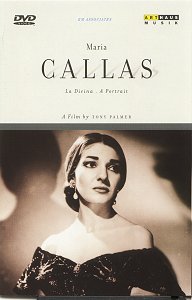 Tony PALMER
Tony PALMER
Maria Callas - La Divina - A Portrait… a film by Tony Palmer
DVD (also available on video) * aspect ratio, 4:3 * sound, Dolby stereo *
PAL * region encoding 2, 5, 6 * languages - English & German * subtitles
in French *
 Arthaus Musick KAT. - NR
100 052
[91:27]
Arthaus Musick KAT. - NR
100 052
[91:27]
Crotchet
Amazon
UK
Amazon
USA

Tony Palmer is the highly respected film maker who has concentrated through-out
his career on classical music documentaries and dramas, making such films
as the nine hour Wagner with Richard Burton and England, My
England, about Handel. He has made acclaimed documentaries on a range
of subjects, including perhaps most memorably, Sibelius. This 1987 production
is a feature length television documentary comprised of archive footage and
new interviews with people who knew Maria Callas.
After a rather disorientating opening five minutes, in which the film seems
to cut about at random to no other purpose than to establish that Maria Callas
became a legend in her own lifetime - lauded as the finest soprano of the
century, reviled by others - the film settles down into standard documentary
fashion, which is to say old fashioned conventional documentary style, before
gimmicky presentation became de rigueur. We learn the bare outline
of Callas' life, from birth in 1923 to death in 1977, via her successes,
her marriage with Meneghini and affair with Onassis. Mostly we listen to
people talk, giving their recollections of the singer's character. Her secretary
recounting an unselfconsciousness at odds with other parts of the portrait.
We are told that the star thought of herself as the woman Maria, and of the
soprano, Callas, almost in the third person, as someone else she became on
stage. We surmise that Callas was an image as much as any glamorous movie
star. There is a rather psychologically tabloid attempt to define the real
woman in-terms of operatic Greek tragedy: Maria could not find love and
fulfilment, sacrificed to the career of Callas. The film would turn life
into art, because it is neater, more comprehensible, more artistic. But it
is too simplistic. We see Callas interviewed, but it is always a public persona.
She eludes us, and Tony Palmer, so he does the best he can to form a narrative
were really there is none. The film and opera director Franco Zeferelli is
most direct and honest, when he says that perhaps her friends, in which he
includes himself, should have done more to support her. We see Callas on
stage, though most of the shots come from the same performance. Most of the
interest comes from seeing what the people we read about look and sound like,
putting faces to names. For deeper insight we must read one of the more than
30 books the film mentions as having been written about Maria Callas (and
that was in 1987, there must be many more now).
Comprised as the film is of newly shot television interviews and old film
and TV archive footage from documentaries and newsreels, picture quality
is not really a primary concern. Nor is the sound, given that we do not get
to hear whole numbers. The picture is certainly considerably cleaner and
more detailed than VHS, and the sound is perfectly adequate, but there is
little real incentive to chose the DVD over the video version. You can listen
to a German voice over, or select subtitles for the opera extracts, but there
are no bonus features. The packaging is first rate, but some background material
could surely have been assembled, a selection of complete arias to compliment
the extracts featured within the body of the film, or an interview with Tony
Thomas about his approach to his subject. Even a discography of Callas and
a list of recommended recordings. In short, some imagination could have been
used. As it is, the film itself is interesting though hardly compelling or
essential viewing. As a package the DVD does not have the substance to warrant
repeated viewing.
Gary S. Dalkin

